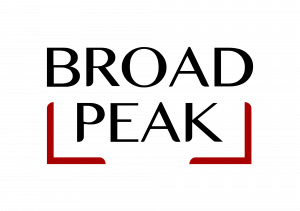It becomes increasingly clear that reducing emissions will not be enough to meet the goals of the Paris Agreement. As per IPCC estimates, we also need to remove around 6 billion tons of carbon dioxide (CO2) from the air every year by 2050 if we want to limit global warming to 1.5 °C. This is where Carbon Dioxide Removal (CDR) comes into the picture. CDR comprises nature as well as Technology-based Solutions (TBS) that capture CO2 from the atmosphere and store it durably in geological formations or in products. Currently, almost all of the CDR comes from nature-based solutions like afforestation and reforestation. However, for longer and more permanent CDR, TBS like Direct Air Capture (DAC) are garnering much attention in business, academic and policy circles. Ramping up TBS like DAC is a key part of the global drive to race to net zero emissions.
At Broadpeak, we collaborate with industry experts, impact-driven investors, and academic institutions to address urgent global challanges. Through our articles and trilogies, we aim to share the insights we have gained from these projects with our network. Explore all of our published articles and trilogies in the blog section of our website.
Removing emissions using Direct Air Capture
DAC is a relatively new carbon sequestration technology that extracts CO2 directly from the atmosphere and permanently stores it in deep geological formations. The captured CO2 can also be used in other processes, for example, to produce synthetic fuels by combining them with hydrogen. Simon Göß, Co-CEO of Carboneer, while speaking to Broadpeak said, “We need to first reduce emissions – that should be our first priority. However, even if we are able to reduce emissions significantly, we will need to remove residual and historic emissions. For this, we need technologies like DAC that have the potential to act as scalable and long-term carbon removal solutions.”
As a negative emission technology, DAC is emerging as a promising complementary solution to sustainable fuel, especially in hard-to-decarbonize sectors. Unlike Carbon Capture and Storage (CCS), which captures emissions at the point source, DAC removes CO2 directly from ambient air. Therefore, in harder-to-abate industries like shipping, aviation, and intensive industrial sectors, which contribute around 50% of total emissions. DAC can help extract residual emissions and draw down historic emissions that are currently warming the planet. Robert Höglund, Climate Advisor at Marginal Carbon AB, told us, “CDR solutions like DAC– where carbon is removed from the air and stored permanently – are vital for removing emissions that are either highly expensive to avoid or where there are currently no alternatives available. Moreover, these solutions enable countries, especially the developed ones, to take responsibility for historic emissions.”
Benefits of DAC as a CDR solution include high storage permanence (when combined with geological storage), durability and a limited land and water footprint. The water requirement for DAC is far lower than pathways that harness bioenergy crops for carbon removal. For instance, bioenergy with CCS requires around 600 m3 of water for each metric ton of CO2 removed while evaporative losses from DAC are less than 25 m3/tCO2. “DAC is a true negative emission technology with limited land use and water requirements. Moreover, it has the potential to attain greater permanence and durability of safe storage plus accurate measurability of carbon removed”, explained Nick Hammer, Program Associate at Direct Air Capture Coalition.
Given the urgency to meet emission targets, governments as well as private companies have started supporting DAC research, development, and deployment. Some of the early supporters include the United States, Canada, the European Union and the United Kingdom. The United States, for example, has enacted a number of acts to advance DAC research and development including the Investment and Jobs Act that allocated USD 3.5 billion in funding to establish four large-scale DAC hubs. More private companies are purchasing offsets and are supporting the development of new DAC plants. For instance, Microsoft is purchasing DAC removal from Orca, the largest operating DAC plant globally.
On the other side of the fence
In terms of cost, DAC is currently one of the most expensive carbon removal technologies. As per the International Energy Agency estimates, the current market price of DAC is between USD 600 / ton and USD 1000 / ton that needs to be brought down to USD 100 / ton to become cost-competitive. “Capturing CO2 from the air is highly energy intensive and therefore generally more expensive than capturing it from a point source at a power station or a cement plant. More research and targeted government support are needed to refine DAC technology and bring down capture costs.” said Göß.
In response to the price argument, Nathalie Casas, Head of R&D at Climeworks told us, “Removing emissions will always be more expensive than reducing emissions. Therefore, DAC should not be seen as an alternative to emission reductions rather it should be used only for non-avoidable and historic emissions.”
In addition, some experts argue that DAC technologies could encourage environmentally hazardous activities like fossil fuel extraction by giving oil producers a free hand in expanding operations. While speaking with Broadpeak, Julia Levin, Associate Director at Environmental Defence, said, “DAC is a relatively new technology. Therefore, it is highly speculative and hypothetical. More research is needed to understand the true potential of DAC. Meanwhile, we should not be making climate plans based on it. In addition, we need to be careful about letting fossil fuel companies use DAC as an excuse to continue polluting the environment.”
Anna Ahn, Corporate Communication Manager at Climeworks, negated claims about DAC being used as a license to pollute by saying, “The technology itself is not promoting the extraction of fossil fuels. It is the responsibility of the developer to ensure that the technology is used in the right way. At Climeworks, we strongly believe in the defossilisation of the economy. We will never lend our technology to extend the life of fossil fuels”.
Questions are raised on the scalability and cost-effectiveness of tech-based solutions and comparisons are drawn between them and nature-based solutions. Muneeb Tariq, NBS Specialist at the WWF, said, “Technologies like CCS and DAC are not yet at the required scale needed to meet the emission targets. Moreover, they are highly expensive, especially for developing countries. However, given the magnitude of the climate crisis, we need to scale up both solutions.”
Scaling DAC to reach Net Zero
We need a large and accelerated scale-up of DAC facilities, which will require several more large-scale DAC plants to refine the technology and reduce costs. To help reach Net Zero emissions by 2050, DAC needs to remove around 85 million tons of CO2 in 2030, and 980 million tons in 2050. However, DAC plants currently remove around 10,000 tons of CO2 per year. According to Ahn, “DAC will help the world reach the last mile towards Net Zero but to be able to reach that last mile it needs to be scaled drastically starting today, or even starting yesterday!”
Large-scale deployment of DAC technologies is only possible through targeted government support and incentives. Government policies go a long way in attracting investors to finance carbon removal projects via tax credits, subsidies and grants. However, so far, only a few countries have made plans to scale up carbon removal. For instance, the Inflation Reduction Act in the US raised the tax credit for permanent carbon removal to USD 180 / ton to attract investors. Developing a pragmatic policy framework alongside CO2 accounting and monitoring systems that recognise and value negative emissions associated with storing CO2 captured from the atmosphere is highly important.
Furthermore, longer-term deployment opportunities will be closely linked to robust CO2 pricing mechanisms and accounting frameworks that recognize and value the negative emissions associated with storing CO2 captured from the atmosphere. Chris Minter, Sustainable Supply Chain Lead at Zurich Insurance, told us, “As a society, we need to set clear standards for what constitutes carbon removal because the market is fragmented with no single standard setter established or universally agreed upon. There need to be agreed standards, ideally backed by governments, particularly regarding the durability and permanence of carbon removal method.”
Höglund puts DAC in another perspective saying: “Nature-based solutions like forestation undoubtedly have a big role to play in meeting climate goals. You can use them to reduce emissions, but you will need more permanent carbon removal solutions for the residual and historic emissions. Moreover, there is not enough land for forestation to remove as much carbon as needed. This is another reason you need complementary tech-based solutions like DAC in the race to Net Zero.”





